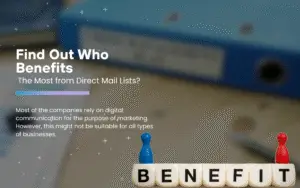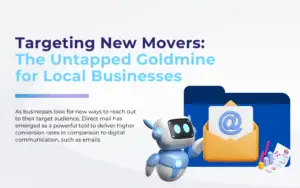When marketing to New Homeowners, we take care of the list for you. You don’t have to worry about the names and whether the address is mailable (some lists provide you addresses even though no one has yet moved in, or worse, the address doesn’t undergo hygiene process, so you end up with returned mail).
We make sure you only target property owners who have just moved in to their new place – so you reach them when they are open to new products, services and service providers (places to get service as they have moved usually more than 5-10 miles away).

But now that we took care of your audience and timely delivery of leads, the question begs – “What do I send them?”.
To that end, let’s take a look at some of the different types of direct mail and their benefits. Using the right type of mailer for the type of prospect you are trying to reach can pay huge dividends in return.
Postcard
Postcards come in a variety of sizes and are very economical to print and have a lower postage rate. Postcards are very effective “attention getters” because there is no envelope to open and your message is easy to read. Postcards are a good way to put a coupon or special promotion in the hands of potential customers. People tend to keep coupons for future use. Oversized postcards create a stronger visual impact than traditional sizes and are more likely to grab the recipients attention.
Letter Package
This is the most traditional and common form of direct mail. The package typically consists of a letter, a flyer, brochure or lift note, an order form or reply card, and an outer envelope. The letter is the most important part of your direct mail package. A very personal letter (e.g., “Dear Mrs. Compton”) has a better chance of connecting with the recipient. The content of the letter typically spells out the benefits of the offer in detail. The outer envelope is a very important part of the package. It has one job – to get itself opened. This is your first, and maybe your last, chance to get the attention of the mail recipient. You can design the envelope to look personal or official depending on the market you are trying to reach. Typically, the more you make the envelope look like a personal correspondence from a friend or family the better. Handwritten text, actual postage stamps, applied return address labels, blue or red ink, invitation style envelopes, or colored envelopes all help to make things look more personal. The strategy of creating an envelope to look official is to make it look like it contains something important or official such as something from the bank or IRS.
Self-Mailer Flyer or “DYI”
A self-mailer flyer is a single sheet of paper (of any size) that is folded one or more times to create a multi-panel flyer. The term self-mailer means they stand alone in the mail and are NOT inserted into an envelope. By eliminating the envelope, you are reducing costs (for both printing and mail inserting).

When you need a little more space for to show your product or need to include more copy than you can on a postcard, a self-mailer is a good choice. This type of direct mail is best used when photos, illustrations and other graphics can contribute to communicating your message.
Three Dimensional Mailer
If you want to send something that’s really going to stand out in the mailbox, then this is your best option. Three-dimensional mailers could be a box, a tube, or a bag and include an object such as a gift or product sample. A mail package with something lumpy inside will get the attention of the person receiving it and most likely will be opened out of curiosity. This type of mailings can be effective in reaching business executives whose mail is screened by a secretary, and they are practically guaranteed to be opened by consumers at home. This type of direct mail is expensive and should be used when you have a relatively small, well-defined audience of otherwise difficult-to-reach prospects.
Catalog
Catalogs are perfect for companies that offer multiple products or services. Catalogs can be custom-designed and vary in size and pages to fit your businesses needs. A good practice is to place your popular items in the front pages to entice the recipient to keep flipping through the catalog. It’s also a good idea to include a coupon(s) or special offer to encourage them to buy.
What To Do Next?
We recommend you also read a bit more about why YOUR business should employ Direct Marketing using New Homeowners who just move to your area of business, as your target audience, each week, like clockworks.
Contact us with any questions you have – our Direct Mail experts will be ready to answer any question and provide you with samples and help creating your first home-brewed Direct Mail campaign.



